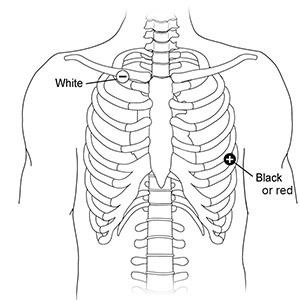Please carefully read and follow this information about your cardiac event recorder. The recorder will help your doctor understand your condition and create the best plan of care for you. If you ever feel like you need medical care right away, call 911 or have someone drive you to the nearest emergency department.
How does the recorder work?
The recorder keeps track of your heart rate and rhythm. The information is sent from two electrodes on your chest through wires connected to the recorder. While you wear the recorder, you will press a button to start an electrocardiograph (ECG) recording if you have any symptoms related to an abnormal heart rhythm.
How long do I need to use the recorder?
- Wear the recorder for 30 days.
- Wear the recorder at all times, except when showering/bathing. Do not get the electrodes, recorder or wires wet!
- Continue to do all your normal activities unless your doctor tells you not to.
How do I attach the electrodes to my chest?

- Change the electrodes every day.
- Attach the wires to the electrodes.
- Clean the areas of your chest where you will place the electrodes (see diagram to the right). Wipe the areas with rubbing alcohol and let them dry.
- Peel off the backing on the electrodes and press the electrodes onto your chest. Make sure they are secure.
- Attach the cable to the recorder.
- The monitor will display a small ECG when there is a good connection. Then, it will display "Monitoring" on the home screen.
- If your skin becomes irritated by the electrodes, call your doctor’s office.
Your doctor needs to know if you have any symptoms or problems while you wear the monitor. Press the Record button every time you have symptoms! Press the Record button again to stop the recording. Your doctor may set the recorder to automatically record. Use your diary to record the date, time, symptoms and what you were doing when they happened.
Urgent symptoms - call 911 or go to the nearest emergency department right away:
- Chest pain, tightness or squeezing; sudden pain in your jaw, back or arm that does not stop after 10 minutes.
- Trouble breathing/feeling short of breath.
- Fainting/nearly fainting.
Non-urgent symptoms include, but are not limited to:
- Fast heartbeats.
- Heart palpitations that can feel like pounding or fluttering in your chest.
- Feeling dizzy or lightheaded.
- Blurred vision.
- Headache.
- Sudden sweating or feeling "clammy".
- If you have an implanted device to control your heartbeat and you feel it go off.
- If you need to take nitroglycerin to control cardiac symptoms.
- Any other symptoms your doctor asks you to record.
How do I send a recording?
The recorder stores 3 ECGs. Please send the recordings after 3 events are recorded or if you have urgent symptoms.
- Remove the cable from the recorder.
- Call the transmission line. The technician will guide you through the transmission process. The information will be sent to your doctor.
Transmission line
216.444.5062 or 800.603.7169.
Please call between 8:00 a.m. and 6:00 p.m., Monday - Friday.
Please only send URGENT transmissions after 6:00 p.m. and on weekends and holidays.
If you have any questions about the recorder, please call 216.444.5001 or 800.223.2273 ext. 45001.
Please promptly return the recorder at the end of the 30-day period.
- Peel off the electrodes and throw them away.
- Return the pouch, recorder, battery holder, cable, wires and patient diary. Use the packing envelope you received with the recorder. You may drop off the package at any UPS location or arrange a home pick-up by calling UPS at 800.337.4877.
- If you got your recorder at a Cleveland Clinic regional location, you must return it to the same location.
- If you got your recorder at Cleveland Clinic’s main campus, you must return it to: Cleveland Clinic Arrhythmia Monitoring Laboratory, Desk J2-2, 9500 Euclid Avenue, Cleveland, Ohio, 44195.
- If you need help returning the recorder, please call the Arrhythmia Monitoring Laboratory, 216.444.5001 or 800.223.2273 ext. 45001.
- If you do not return the monitor or if it is damaged, you will be financially responsible for the replacement cost.